首页 > 代码库 > Linux-unit7-9
Linux-unit7-9
七单元
1、进程的状态
运行、停止、休眠、僵尸进程(进程已经关闭但仍然占用内存)、结束
2、查看进程命令
ps -a 查看shell中运行的进程(-a表示只能查看shell前端的进程,a表示可以查看所 有与shell有关的进程)
-x 查看不在shell中运行的进程
-u 查看进程的用户
-l 查看进程的详细信息
-f 查看进程的完全信息(full的缩写)
-e 显示系统中所有的进程
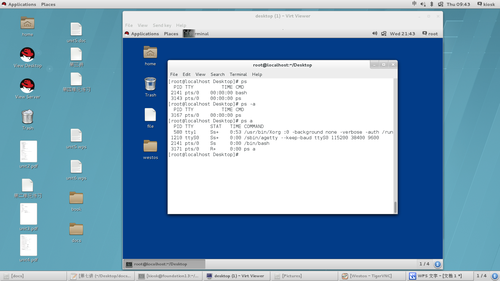
ps -aux |grep 进程关键字(eg:fan)
ps ax -o %cpu,%mem,user,pid,comm 查看进程的某一项的信息
ps aux --sort +|-%cpu |%mem.... 表示对按照指定方式对进程进行排序(+表示正序;-表示逆序)

3、控制shell中进程的前后台调用
命令& 关闭终端占用,让进程在shell后台运行
Ctrl+z 把进程打入后台后停止
jobs 查看后台的进程信息
fg job号 把指定的进程调回前台
bg job号 运行后台停止的进程
Crlt+c 关闭占用shell的进程
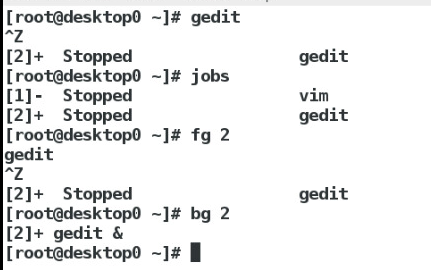
4、用命令控制进程
信号1 reload进程(不停止进程的情况下重新读取进程的配置文件)
信号2 与crtl+c功能相同,删除进程在内存中的信息
信号3 清除鼠标(crtl+\)(ctrl+alt 显示鼠标)
信号9 强行关闭进程
信号15 正常关闭进程
信号18 开启停止的进程
信号19 暂停进程
信号20 同crtl+z作用相同
kill 信号 pid ##根据进程号对进程进行操作
killall 信号 进程名称 ## 对同一进程名称的所有进程进行操作
pkill -u username ##结束某个用户的所有进程
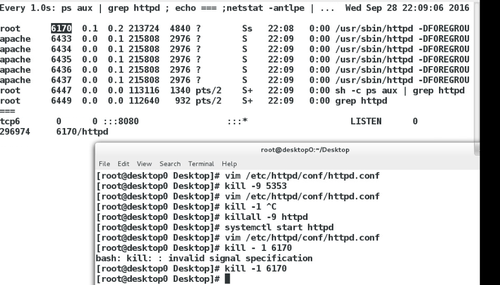
5、用户登陆监控
查看ip地址:ifconfig eth0
连接虚拟机:ssh root@712.25.13.10 (虚拟机ip地址)
w 查看正在连接的用户
w -f 查看当前使用的用户并显示使用的地点
last 查看登陆过系统的用户
lastb 查看登陆过系统但没有成功的用户


6、top命令
u username 查看用户信息
k 信号
h 显示帮助画面
s 使top命令在安全模式下运行
m 切换显示内存信息
c 切换显示命令名称和完整命令行
八单元
1、服务管理,systemctl命令
systemctl start 服务名称 开启服务
stop 关闭服务
restart 重启服务
reload 重新加载服务器
status 查看服务器状态
enable 设定服务器开机启动
disable 禁止服务器开机启动
list-dependencies 查看服务依靠关系
list-units 查看当前运行的所有服务
list-unit-files 查看服务的开机启动情况
set-default multi-user.target 开机不启动图形
set-default graphical.target 开机启动图形

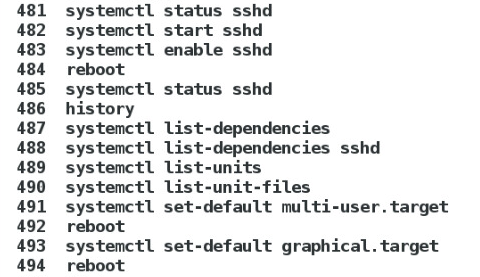
九单元
1、openssh
重启网络获取ip:systemctl restart network
虚拟机被访问前两边都要执行rm-fr /root/.ssh
ssh root@172.25.13.11 -X (-X表示可以访问图形界面)
2、实现远程访问
ssh 远程主机用户@远程主机ip地址 (ssh root@172.25.254.205)
[kiosk@foundation13 Desktop]$ ssh root@172.25.13.11 ##远程访问
The authenticity of host ‘172.25.13.11(172.25.13.11)‘ can‘t be established.
ECDSA key fingerprint iseb:24:0e:07:96:26:b1:04:c2:37:0c:78:2d:bc:b0:08.
Are you sure you want to continueconnecting (yes/no)? yes
Warning: Permanently added ‘172.25.13.11‘(ECDSA) to the list of known hosts.
root@172.25.13.11‘s password: ##输入密码
Last login: Thu Sep 29 04:50:59 2016
[root@server13 ~]# logout ## crtl+d退出
Connection to 172.25.13.11 closed.
[kiosk@foundation13 Desktop]$
vim /etc/motd 设定登陆时显示的字符
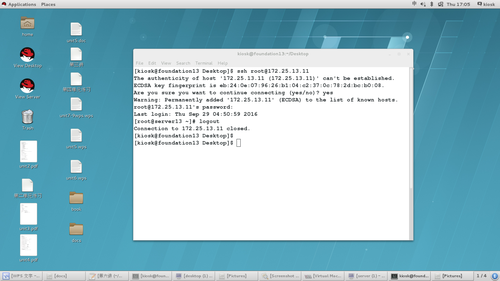
3、ssh的key认证
[root@server13 Desktop]# ssh-keygen
Generating public/private rsa key pair.
Enter file in which to save the key(/root/.ssh/id_rsa):
Enter passphrase (empty for no passphrase):
Enter same passphrase again:
Your identification has been saved in/root/.ssh/id_rsa.
Your public key has been saved in/root/.ssh/id_rsa.pub.
The key fingerprint is:
26:20:15:ed:3f:5e:50:8e:69:d6:d5:d0:9c:7a:60:29root@server13.example.com
The key‘s randomart image is:
+--[ RSA 2048]----+
| oo .* . |
| . . E = = |
| ... * + o |
| ... * o . . |
| .+S. . |
| oo . |
| . o |
| . |
| |
+-----------------+
[root@server13 Desktop]# cd /root/.ssh/
[root@server13 .ssh]# ls
id_rsa id_rsa.pub
[root@server13 .ssh]#

ssh-copy-id 上传key
-i 指定所使用的公钥
id_rsa.pub 公钥的名称
root 被管理的目标用户
172.25.13.11 被管理用户所在主机的ip
authorized_keys 此文件在目标用户家目录的 .ssh中,是目标用户的被加密的标识, 内容为公钥。
ssh-keygen
ssh-copy-id -i id_rsa.pub westos@172.25.13.10(服务器端ip) 给指定主机加密(上锁)
scp id_rsa root@172.25.13.11:/root/.ssh/ 将秘钥上传给指定主机(客户端ip)
4、sshd服务配置
vim / etc/ ssh/ sshd_config sshd服务的配置文件(set nu 显示行号)
48 PermitRoorLogin yes | no 设置是否允许root用户通过sshd认证
78 PasswordAuthentication yes | no 开启或关闭用户密码认证
AllowUsers student westos(用户名) 用户白名单(没有列出的用户不能登陆系统加在49行下边)
systemctl restart sshd 重新加载配置
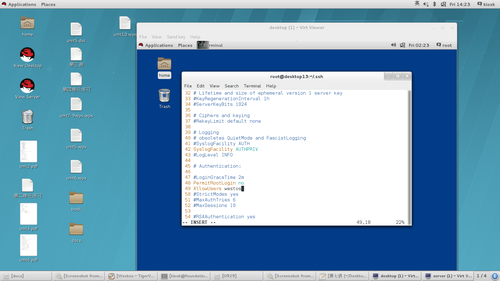
yum reinstall openssh-server -y 重新安装ssh服务(若有错误执行yuminstall openssh-server -y)
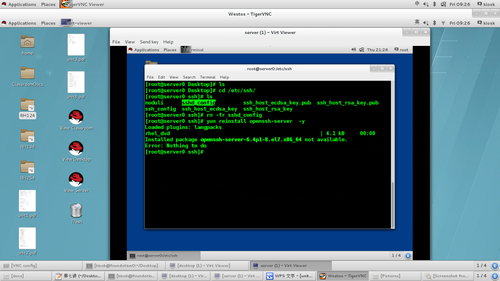
本文出自 “12086808” 博客,请务必保留此出处http://12096808.blog.51cto.com/12086808/1859146
Linux-unit7-9
